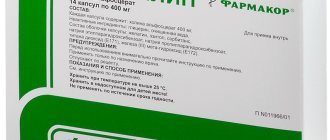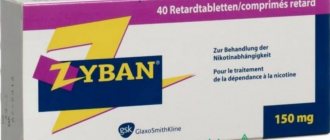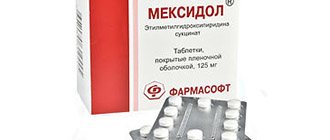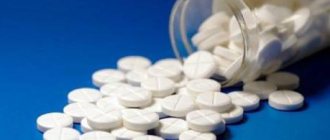Cipralex
Use during pregnancy and breastfeeding
Contraindicated for use during pregnancy and lactation (breastfeeding).
Use for liver dysfunction
Should be used with caution in case of liver cirrhosis.
Use for renal impairment
It should be used with caution in patients with renal failure (creatinine clearance less than 30 ml/min).
Use in children
Contraindicated in children and adolescents under 15 years of age.
Use in elderly patients
Should be used with caution in elderly patients.
special instructions
Use with caution in patients with renal failure (creatinine clearance less than 30 ml/min), hypomania, mania, pharmacologically uncontrolled epilepsy, depression with suicidal attempts, diabetes mellitus, elderly patients, cirrhosis of the liver, a tendency to bleeding, simultaneously with taking medications that reduce the threshold of convulsive readiness, causing hyponatremia, with ethanol, with drugs metabolized with the participation of isoenzymes of the CYP2C19 system.
Escitalopram should be prescribed only after 2 weeks. after discontinuation of irreversible MAO inhibitors and 24 hours after discontinuation of therapy with a reversible MAO inhibitor. Non-selective MAO inhibitors can be prescribed no earlier than 7 days after discontinuation of escitalopram.
Some patients with panic disorder may experience increased anxiety at the beginning of treatment with escitalopram, which usually disappears over the next 2 weeks. treatment. To reduce the likelihood of anxiety, low initial doses are recommended.
Escitalopram should be discontinued if epileptic seizures develop or become more frequent in pharmacologically uncontrolled epilepsy.
If a manic state develops, escitalopram should be discontinued.
Escitalopram can increase the concentration of glucose in the blood in diabetes mellitus, which may require dose adjustment of hypoglycemic drugs.
Clinical experience with escitalopram indicates a possible increase in the risk of suicide attempts in the first weeks of therapy, and therefore it is very important to carefully monitor patients during this period.
Hyponatremia associated with decreased ADH secretion occurs rarely with escitalopram and usually disappears when it is discontinued.
If serotonin syndrome develops, escitalopram should be immediately discontinued and symptomatic treatment prescribed.
Impact on the ability to drive vehicles and operate machinery
During the treatment period, patients should avoid driving vehicles and other activities that require high concentration and speed of psychomotor reactions.
Cipralex 5 mg 28 pcs. film-coated tablets
Composition and release form Cipralex 5 mg 28 pcs. film-coated tablets
Film-coated tablets - 1 tablet. escitalopram (in the form of oxalate) - 5 mg of the composition component without quantity excipients: talc; croscarmellose sodium; MCC; colloidal silicon anhydrous; magnesium stearate shell: hypromellose; macrogol 400; titanium dioxide (E171) in blister packs 14 pcs.; in a cardboard pack 2 packages (5 mg, 20 mg) or in a cardboard pack 1, 2 or 4 packages (10 mg).
Description of the dosage form
Tablets 5 mg: white, convex, round, 6 mm in diameter, marked “EK”; at the break - the core and shell are white. Tablets 10 mg: white, convex, oval (8 mm x 5.5 mm), scored, marked “E” and “L” symmetrically near the score; at the break - the core and shell are white. Tablets 20 mg: white, convex, oval (11.5 mm x 7 mm), scored, marked “E” and “N” symmetrically near the score; at the break - the core and shell are white.
Characteristic
Antidepressant, SSRI.
Directions for use and doses
Cipralex is prescribed once a day, regardless of food intake. Depressive episodes: Cipralex 10 mg once daily is usually prescribed. Depending on the patient’s individual response, the dose of Cipralex can be increased to a maximum of 20 mg/day. The antidepressant effect of Cipralex usually develops 2-4 weeks after the start of treatment. After the symptoms of depression disappear, Cipralex therapy must be continued for at least another 6 months to consolidate the effect obtained. Panic disorder with/without agoraphobia: During the first week of treatment with Cipralex, a dose of 5 mg/day is recommended, which is then increased to 10 mg/day. Depending on the patient’s individual response, the dose of Cipralex can be increased to a maximum of 20 mg/day. The maximum therapeutic effect of Cipralex is achieved approximately 3 months after the start of treatment. Therapy with Cipralex lasts several months. Discontinuation of treatment: When discontinuing treatment with Cipralex, the dose should be gradually reduced over 1-2 weeks in order to avoid withdrawal symptoms.
Pharmacodynamics
Inhibition of serotonin reuptake leads to an increase in the concentration of this neurotransmitter in the synaptic cleft, enhancing and prolonging its effect on postsynaptic receptor sites. Escitalopram has no or very weak ability to bind to a number of receptors, including: serotonin 5-HT1A, 5-HT2 receptors, dopamine D1 and D2 receptors, alpha1, alpha2, beta adrenergic receptors, histamine H1 receptors , m-cholinergic receptors, benzodiazepine and opioid receptors.
Pharmacokinetics
Absorption Absorption is independent of food intake. The bioavailability of escitalopram is about 80%. The average time to reach Cmax in blood plasma is about 4 hours after repeated use. Distribution The binding of escitalopram and its main metabolites to plasma proteins is below 80%. The apparent volume of distribution after oral administration is from 12 to 26 l/kg. The kinetics of escitalopram is linear. CSS is achieved in approximately 1 week. An average CSS of 50 nmol/L (range 20 to 125 nmol/L) is achieved with a daily dose of 10 mg. Metabolism Escitalopram is metabolized in the liver to demethylated and didemethylated metabolites, which are pharmacologically active. The main substance and its metabolites are partially released in the form of glucuronides. After repeated use, the average concentration of demethyl and didemethyl metabolites is usually 28-31% and less than 5%, respectively, of the concentration of escitalopram. Biotransformation of escitalopram into a demethylated metabolite occurs mainly with the participation of the CYP2C19 isoenzyme. Some participation of isoenzymes CYP3A4 and CYP2D6 is possible. In individuals with weak CYP2C19 activity, the concentration of escitalopram may be 2 times higher than in cases with high activity of this isoenzyme. No significant changes in the concentration of the drug were found in cases with weak activity of the CYP2D6 isoenzyme. T1/2 excretion after repeated use is about 30 hours. Cl when administered orally is about 0.6 l/min. The main metabolites of escitalopram have a longer T1/2. Escitalopram and its main metabolites are excreted by the liver (metabolic pathway) and kidneys. Most of it is excreted in the form of metabolites in the urine. Pharmacokinetics in special clinical situations: In elderly patients (over 65 years of age), escitalopram is eliminated more slowly than in younger patients. The amount of the substance in the systemic circulation, calculated using AUC in the elderly, is 50% greater than in young healthy volunteers.
Indications for use Cipralex 5 mg 28 pcs. film-coated tablets
Cipralex is an antidepressant, a selective serotonin reuptake inhibitor. Used for depressive episodes of any severity and panic disorders. Composition and release form: Cipralex film-coated tablets, packaged in 14 or 28 pcs. 1 tablet of Cipralex contains escitalopram oxalate in an amount corresponding to 5, 10 or 20 mg of escitalopram. Indications for use of the drug Cipralex:
- depressive episodes of any severity;
- panic disorder with/without agoraphobia.
Contraindications
- hypersensitivity to Cipralex or its components;
- children's age (up to 15 years);
- simultaneous use with monoamine oxidase inhibitors (MAO);
- pregnancy, breastfeeding period.
Application of Cipralex 5 mg 28 pcs. film-coated tablets during pregnancy and breastfeeding
Cipralex is contraindicated for use during pregnancy and lactation (breastfeeding). The use of SSRIs in the third trimester of pregnancy can negatively affect the psychophysical development of the newborn. The following disorders have been reported in newborns whose mothers took SSRIs until birth: irritability, tremors, hypertension, increased muscle tone, constant crying, difficulty sucking, poor sleep. Abnormalities may indicate serotonergic effects or the occurrence of a withdrawal syndrome. If SSRIs are used during pregnancy, their use should not be abruptly interrupted.
Overdose
Symptoms: dizziness, tremor, agitation, drowsiness, confusion, seizures, tachycardia, ECG changes (changes in the ST segment and T wave, widening of the QRS complex, prolongation of the QT interval), arrhythmia, respiratory depression, vomiting, rhabdomyolysis, metabolic acidosis, hypokalemia. Treatment: There is no specific antidote. Treatment is symptomatic and supportive: gastric lavage, adequate oxygenation. Monitoring the function of the cardiovascular and respiratory systems.
Side effects Cipralex 5 mg 28 pcs. film-coated tablets
Side effects most often occur during the 1st or 2nd week of treatment with Cipralex and then usually become less intense and occur less frequently as therapy is continued. The most common symptoms are: nausea, loss of appetite, diarrhea, constipation, insomnia or drowsiness, dizziness, weakness, increased sweating, hyperthermia, sinusitis, decreased libido, impotence, impaired ejaculation, anorgasmia (in women). Less common are taste disturbances and sleep disturbances. Also possible: orthostatic hypotension, hyponatremia, insufficient secretion of antidiuretic hormone (ADH), visual disturbances, vomiting, dry mouth, dizziness, weakness, anaphylactic reactions, changes in laboratory tests of liver function, arthralgia, myalgia, seizures, tremor, movement disorders, serotonin syndrome, hallucinations, mania, confusion, agitation, anxiety, depersonalization, panic attacks, increased irritability, urinary retention, galactorrhea, skin rash, itching, ecchymosis, purpura, angioedema, increased sweating.
Drug interactions
Pharmacodynamic interaction With the simultaneous use of Cipralex with MAO inhibitors, as well as when starting to take MAO inhibitors in patients who have recently stopped taking Cipralex, serious adverse reactions may occur. In such cases, serotonin syndrome may develop. Concomitant use of Cipralex with serotonergic drugs (for example, tramadol, sumatriptan and other triptans) may lead to the development of serotonin syndrome. Cipralex may lower the seizure threshold. Caution is required when prescribing Cipralex and other drugs that lower the seizure threshold at the same time. Since there have been cases of increased effects when Cipralex is co-administered with lithium or tryptophan, caution is recommended when prescribing these drugs simultaneously. The simultaneous administration of Cipralex and drugs containing St. John's wort (Hypericum perforatum) may lead to an increase in the number of side effects. When escitalopram is co-administered with oral anticoagulants and drugs that affect blood clotting (for example, atypical antipsychotics and phenothiazines, most tricyclic antidepressants, acetylsalicylic acid and NSAIDs, ticlopidine and dipyridamole), a blood clotting disorder may occur. In such cases, careful monitoring of blood clotting is necessary at the beginning or at the end of therapy with escitalopram. When taken concomitantly with alcohol, escitalopram does not interact pharmacodynamically or pharmacokinetically. However, as with other psychotropic drugs, the simultaneous use of escitalopram and alcohol is not recommended. Pharmacokinetic interaction: Concomitant use with drugs that inhibit the CYP2C19 isoenzyme may increase the concentration of escitalopram in the blood plasma. Escitalopram should be used with caution simultaneously with similar drugs (including omeprazole); A dose reduction of escitalopram may be required. Caution should be exercised when Cipralex is administered in high doses concomitantly with high doses of cimetidine, which is a strong inhibitor of the CYP2D6, CYP3A4 and CYP1A2 isoenzymes. Escitalopram is an inhibitor of the CYP2D6 isoenzyme. Caution should be exercised when simultaneous administration of escitalopram and drugs that are metabolized by this isoenzyme and have a low therapeutic index, for example, flecainide, propafenone and metoprolol (in cases of use for heart failure) or drugs that are mainly metabolized by the CYP2D6 isoenzyme and act on the central nervous system. for example, antidepressants (desipramine, clomipramine, nortriptyline) or antipsychotics (risperidone, thioridazine, haloperidol). In these cases, dose adjustment may be required. The simultaneous administration of escitalopram and desipramine or metoprolol leads to a twofold increase in the concentration of the latter two drugs. Escitalopram may slightly inhibit the CYP2C19 isoenzyme. Therefore, it is recommended to exercise caution when using escitalopram simultaneously with drugs metabolized by this isoenzyme.
Interaction
The simultaneous use of Cipralex and drugs that irreversibly inhibit monoamine oxidase , since the percentage of severe side effects increases several times (the percentage of respiratory or heart failure ).
Based on pharmacological studies, it is not recommended to include Cipralex and reversible MAO inhibitors due to the risk of serotonin syndrome (a potentially fatal situation).
The drug with escitalopram in parallel with anticoagulants or drugs that reduce blood clotting , as this can lead to severe hemorrhagic syndrome and anemia as an outcome of the pathological situation, which will complicate the treatment of the patient.
There are a number of pharmaceutical drugs that, by interacting with the allosteric centers of carrier proteins, increase the activity of Cipralex. For example, Omeprazole (an anti-ulcer drug) leads to a twofold increase in the concentration of the active substance in the systemic circulation, and Cimetidine (a H2-histamine receptor blocker, which is prescribed for pathology of the gastrointestinal tract) - by 70%.
Drugs that inhibit serotonin , and Cipralex, as a typical representative of this pharmacological group, reduces the threshold of convulsive activity, that is, tremor and/or convulsive syndrome may manifest itself in response to less intense excitation. This effect will be potentiated if Cipralex and other strong antipsychotic substances ( neuroleptics ) are taken simultaneously, for example Tramadol, Phenothiazine, Butyrophenone, and so on.
Cipralex price, where to buy
The price of Cipralex, of course, depends on the dosage of the biologically active component. You can buy it in Moscow for 900/1400/1800 rubles, respectively 5/10/20 mg of the active ingredient. In Ukraine, the cost of an antidepressant varies from 270 to 500 hryvnia, but the vast majority of pharmacies sell the drug for 400 hryvnia.
- Online pharmacies in RussiaRussia
- Online pharmacies in UkraineUkraine
ZdravCity
- Cipralex tablets p.p.o.
10 mg 14 pcs. Lundbeck 1072 rub. order - Cipralex tablets p.p.o. 10mg 28 pcs.Lundbeck
RUB 2,227 order
Pharmacy Dialogue
- Cipralex (tab.p/vol.10mg No. 14)Lundbeck
RUB 1,053 order
- Cipralex (tab.p/vol.10mg No. 28)Lundbeck
RUB 2,274 order
show more
Reviews of Cipralex
Those who took Cipralex are overwhelmingly satisfied with the effects of conservative treatment. The drug really helps to cope with phobias of various origins, allowing you to live a fuller life, not limited by fears, anxieties or worries about trivial reasons. However, recipients' feedback is often clouded by personal experiences of adverse reactions. Especially often there is a broken state , insomnia , and constant painful agitation .
Also, reviews of Cipralex on the forums say that in the vast majority of cases, libido and/or potency ( erectile dysfunction , dystonia of the muscles responsible for reproductive functions, changes in the perception of sexual intercourse, and so on). Both men and women complain about this side effect in equal numbers. What is interesting is that reviews of those taking antidepressants are also full of gratitude to the drugs for reducing desire, since satisfying animal instincts did not bring joy or long-awaited relief during depression.
Reviews from doctors about Cipralex primarily clinically and statistically confirm the effectiveness of the drug in the conservative treatment of neurological disorders . An antidepressant of such strength copes with depression and psychosis where more gentle methods do not bring any results. Side effects are perceived by specialists as necessary losses, because undesirable manifestations will disappear after a full course of sanitation.
Cipralex's analogs
Level 4 ATC code matches:
Actaparoxetine
Plizil
Fluxen
Paroxin
Surlift
Asentra
Elycea
Fluoxetine
Lenuksin
Escitalopram
Adepress
Selectra
Stimuloton
Citalopram
Cipramil
Zoloft
Paroxetine
Prozac
Paxil
Rexetine
Currently, the following analogues of Cipralex can be found on pharmacy shelves: Escitolopram-Teva, Selectra, Elitseya, Miracitol .
Instructions for use of Cipralex (Method and dosage)
The use of Cipralex does not depend on meals during the day. The duration and intensity of the course of conservative treatment largely depends on the initial disease:
- So, to achieve an antidepressant effect, loading doses are used for 2-4 weeks (10 mg of Cipralex per day for an adult patient) and maintenance therapy for the next 6 months to consolidate the results obtained.
- The instructions for Cipralex for panic disorders are very different - pharmacological therapy begins with 5 mg of the drug with a further increase in the daily dose to 10 mg. Depending on the individual reaction of the body, the amount of the drug can be increased to 20 mg per day. The maximum effect is achieved after 3 months, but rehabilitation can last up to six months.
- In patients with renal or liver failure (both acute and chronic), but with absolute indications for the use of Cipralex, the maximum single dose is 5 mg. An increase is not recommended, but if the desired therapeutic effect is not achieved, then the amount of the administered drug is doubled.








